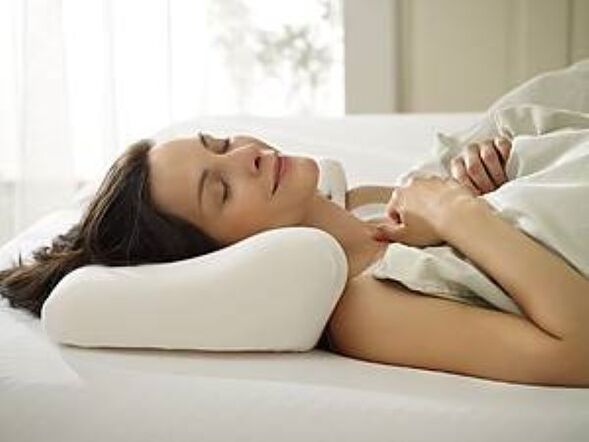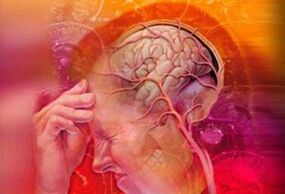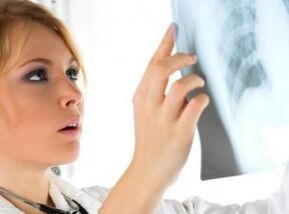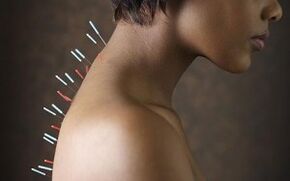Osteochondria today is rightly considered the "disease of the century" because most people suffer from people whose work does not require increased motor activity.
In most cases, changes in cartilage and bone tissue to people of working age - up to 40 years are observed.
The disease can affect various parts of the spine and the second most prevailing is the cervical osteochondria.
What is it?
Osteochondria is dystrophic disorders of articular cartilage and adjacent bone tissue.
Previously, the term has been extended to a large group of bone artistic diseases, but now it is now used only with degenerative spine disease.

Compared to other parts of the spine, the cervical area is the most mobile and has many nervous and vascular formations.The structure of the vertebrae is small in size, as well as the fact that it is surrounded by a fairly weak muscle corset.
Such anatomical structure predisposes to the development of osteochondrialism, the severity of clinical manifestations of which depends on the nature of changes in the intervertebral discs and the degree of destruction.
The causes of the development of the disease
The main and most common cause of cervical spine is a sedentary lifestyle.
Due to the lack of physical activity with a sedentary and sedentary lifestyle:
- Metabolic processes are violated.
- The level of salts in the bloodstream and the lymphatic fluid increases.
- In the cervix area, the kidneys and the liver of the spine, salts are placed.
Cervical vertebrae damage is mainly determined by the lack of nutrients in intervertebral discs.Therefore, the main reasons for the emergence of cervical osteochondination also include inappropriate and unbalanced diet.
Risk factors
There are many risk factors for cervical osteochondria.

The most common factors are:
- heredity;
- Age -related changes.
- Injuries to the cervical spine.
- hypothermia.
- hormonal disorders that lead to metabolic disorders.
- Some autoimmune diseases that lead to damage to cartilage tissue (systemic wolf erythematosus, rheumatism).
What is dangerous
Not only do spinal cord and nerve roots pass through the cervical spine, but also the spine, which is responsible for providing the blood of the back of the brain, an elongated brain and cerebellum.
Therefore, with the cervical osteochondria, this artery is compressed and therefore violates brain circulation.
In particularly advanced cases, compression of the artery and adjacent blood vessels and nerve knitting can lead to such consequences as:
- violation of coordination;
- decrease in hearing and vision;
- rap.
If you do not cure the disease at the initial stage, then this can lead to complications such as: projection of the intervertebral disc or intervertebral disc hernia.
The degree of development of the disease
Cervical osteochondria, such as the osteochondria of other spine, gradually develops.There are 3 stages of disease development.
1 grade
It is characterized by the onset of the disaster of intervertebral discs.
The cracks are formed in the fibrous ring, the durability and elasticity of the disc are formed, its height is reduced, by which the nerve roots are compressed.
A characteristic pain of pain appears.Sometimes in 1 stage (preclinic) such a pain may be absent and the osteochondria progresses with moderate neck discomfort.
2 degrees
If the 1st degree osteochondria was not treated or the treatment was not effective, then a chronic condition occurs, which is the 2nd degree of osteochondicism.
The pain becomes constant, the destruction and seal of the intervertebral disc continues and leads to small cervical vertebrae outbreaks.
With cervical osteochondria, a downfall syndrome may develop at this stage.This syndrome is characterized by severe pain and a person is forced to support their head in stable condition to reduce pain.
3 degrees
The cervical osteochondria of the 3rd degree is accompanied by the following signs:
- headaches?
- nausea;
- dizziness;
- cervical "bastards".
- Violation of the sensitivity of the upper extremities.
The fibrous ring has already been almost destroyed, which leads to complications of osteochondicism - protrusion of the intervertebral disc or intervertebral hernia.
In 3 stages of osteochondry, pain intensity can be reduced, since the affected cartilage tissue on the intervertebral disc simply does not exist, which means that there is no source of pain, but the nerve sting remains, so the pain does not.
Characteristic features and symptoms
There are many signs of manifestation of this disease.And depend on which vertebrae has been damaged by this disease.

Typical syndromes for cervical osteochondria are:
- Spine syndrome.
- Spine syndrome.
- Cervical migraine syndrome.
- Hypertension syndrome.
All of these syndromes are accompanied, first of all, with different types of pain.
If we consider the spinal artery syndrome, then the headache here manifests itself at the early stage of disease development.
At the same time, pain attacks may be accompanied by:
- dizziness;
- Walking shake?
- The visual symptoms (the appearance of the fog in front of the eyes, the reduction of visual acuity, etc.).fainting (with sharp movements of the head).
With hypertension syndrome, increased intracranial pressure is determined.
A headache is more explosion, it may be accompanied by nausea and vomiting.With the deterioration of cervical osteochondrication, an increase in temperature and an increase in ESR can be observed.
When compressing the roots of the spine ("Roying Syndrome"), the following neurological symptoms may occur:
- It is pronounced pain in the throat (cervical).
- Throat pain, spreads to the bone of the forearm and shoulder (cervical).
- hand pain;
- Sensations of the crisis or the garden in the throat when you turn your head.
- The pain "gives" the ear, which occurs only after a long stay in an unpleasant position or a sharp movement.
- pain or feeling of coma in the throat, respiratory disorders.
- numbness of hands and tongue.
- a feeling of swelling of language.
- It is pronounced weakness.
- violation of hearing and vision;
- noise in the ears.
- General deterioration of prosperity.
With the "cervical migraine" syndrome, the sympathetic nodes are irritated, which leads to weakened reactivity of the brain vessels and circulatory disorders.

As a result, hypertension can be developed, often accompanied by:
- Ears with congestion.
- tachycardia;
- noise on the head;
- Call to the ears.
When compressing blood to the spinal cord of arteries, a vertebral stroke can occur.
The breakdown of blood circulation in the brain with osteochondria can lead to:
- Oxygen deficiency of brain cells.
- mental disorders (state of depression, panic attacks);
- The appearance of episode points, such as short -term losses of consciousness and intensity of the whole body - is often confused with signs of epilepsy.
Such a sign of cervical osteochondicity as changes and rhythm of the heart, such as extracurricular or arrhythmia, is very common.
These signs are very common between drivers and office employees.
Due to the sedentary lifestyle in the intervertebral dishes of the cervical and thoracic spine, changes occur, leading to heart disorders.
In most cases, it will be almost impossible to get rid of disorders in the rhythm of the heart.
The swelling under the eyes can also indicate osteochondria of the cervical region.
Most of the time they depend on the position of the head during the night sleep, they spend all day and combine with headaches, dizziness, head gravity, etc.
Vegetable -angry dystonia is another of the common diseases that occur in this disease.
It is a consequence of the gum of the vascular arteries that pass on the sides of the spine.
Diagnostic methods
A preliminary diagnosis is determined by a neurologist during the initial examination of the patient.More recently, the doctor had to diagnose, having only performed an external examination of the patient and sent him to the X -Ray.
But, unfortunately, in x -ray, it is impossible to see a complete picture of the development of the disease.

Currently, exams such as computed tomography and magnetic resonance imaging are available, with which you can fully evaluate what stage of development the disease is.
After diagnosis, the patient goes to the doctor specializing in this area.
Which doctor is facing?
A narrow specialist orientation deals with treatment - a sponge or a vertebrate.
Treatment of osteochondry
The basis for the treatment of cervical osteochondrication is the severity of the main clinical symptoms.
In the cervical area, the symptoms are mainly related to the compression of blood vessels and nerve seals, so during treatment, edema is mainly relieved and blood circulation is restored.
There are many methods of treatment used in the treatment of cervical spine osteochondry.
The most effective treatment is a complex, which is a combination of several conservative treatment methods.
The complex treatment of cervical osteochondrication may include the following traditional and non -traditional methods: treatment of drugs, massage, acoustic, manual treatment, physiotherapy, acupuncture, homeopathy, folk remedies, etc.
The stages of treatment for osteochondria are the same for all detections of this disease:
- First you need to remove the pain syndrome.
- Then the edema will be removed.
- At this stage, it is necessary to normalize blood circulation.
- Enhancement of Muscle corset.
- Improvement of diet and tissue regeneration.
Only the team of good experts, which includes a neurologist, physiotherapist, masseur, surgeon, spondrophroferologist, can choose the most appropriate treatment.
Like any disease, it cures the cervical osteochondria at the very early stage of appearance.If you do not start the process, then at this stage you can achieve a complete treatment of osteochondry.
Unfortunately, 2 and 3 stages of cervical osteochondrication are accompanied by complete or partial destruction of intervertebral discs, so these stages are characterized by a very long recovery process.
First aid
How to relieve pain with frenzy?
With severe pain, you need to get anesthetic from a closet at home.You can also glue a papper of pain.
When edema occurs, diuretics can be obtained.Rubbing the neck area with painkillers can help.
Medical physical education in exacerbations is contraindicated as well as heating, as these influences can cause serious complications.
After removing acute pain, you should urgently consult your doctor for consultation.
Drug treatment
Medicines start more frequently with injections (with exacerbations), then go to tablets and candles in combination with the topical use of ointment and gels.
Anesthesia in treatment with drugs is performed using anti -inflammatory steroids.
Make sure you have prescribed drugs that restore brain circulation.
With muscle pathological intensity, muscle relaxation can be prescribed, such as Midocalm.For more effective treatment, vitamins are obtained in the therapeutic dose and trace elements.
In cases of intervertebral hernia, surgical intervention is not rarely recommended and the treating doctor may offer a business.
Massage and self -mast
This method goes well with physiotherapy and physiotherapy.You can take a massage lesson to any medical institution and you can turn to private practices.
Massage is essential for cervical osteochondria to enhance muscle and relieve tension in the throat.
The task of the massage therapist is to remove the harmful products of metabolism, as well as to relieve spasm from the pathology zone by increasing the outflow and flow of blood in the wound zone.
The main techniques used by experts during neck massage are:
- caressing;
- pressure;
- pulverization;
- vibration;
- kneading.
The self -mastery technique can be performed using the following techniques:
- Characteristic (the movements must be soft, without much effort to form folds).
- fermentation (deep effect on the muscles, with the conception of fold, pressure and push).
- Vibration (oscillating results with shading, shake, slaps).
The self -mast must always be completed by caressing.During vibration, you can use a massage.
Supreme massage
Surplus massage relieves headache with deterioration of cervical osteochondrication, helps with increasing pressure, smoothing it.
Acupressure plan:
- The impact on the feng fu, which is located below the occipital hill, for 1 minute.
- The impact on the feng-chi point, which is on the width of two fingers from the special skull processes.
- Exposure for 1-1.5 minutes at point I-Men (located three fingers from the Fen-Fu point).
- The sedative exposure is 1-1.5 minutes at the point of pin (7th cervical vertebra).
After Acupressure, it is necessary to lie down for several minutes, as a slight dizziness can occur.
Manual treatment
Manual treatment helps to treat both acute and chronic pain, also increases the volume of movements and improves posture.
The main techniques of manual treatment for cervical spine osteochondria:
- Relaxation and partial massage.Used to warm the muscles and relieve tension.
- Mobilization.Impacts aimed at restoring common functions.The traction method.
- Handling.A sharp thrust that aims at the patient's pathological zones.The process is accompanied by a characteristic crisis (the return of the joint to normal).
A specialized manual treatment should perfectly have these techniques.Otherwise, any mistake can lead to injuries.
Acupuncture
Acupuncture contributes to the release of cortisol in the blood.This hormone has a strong anti -inflammatory effect.

Acupuncture is performed by exposure to points near the inner edge of the shoulder blade.The needles are inserted at a depth of 1 - 2 cm and left for exposure in 10 - 30 minutes.
Homeopathy
Treatment with medication has many adverse effects with it, so homeopathy can become a worthy replacement for treatment without unwanted consequences.
With the cervical osteochondria with severe hypertension (expressed by pain in the back of the head), an carbonate stronine is used.
Assign to 3, 6, 12 and 30 reproduction.
Characteristics
Foods must be saturated with calcium and magnesium.
These trace elements are found in fish and seafood, in nuts, legumes and dairy products.
Often the osteochondria of the throat may be accompanied by atherosclerosis.In this case, a hard diet is recommended.
The diet is prescribed for 3-4 months.It is necessary to limit the consumption of all cholesterol -containing products.These include animal fats, greasy varieties of meat, fatty dairy products, etc. Also, consumption of salt, sugar, flour products must be limited or excluded.
It is recommended to abandon bad habits (smoking, alcohol, etc.).
Cervical osteochondria and alcohol are interconnected.The fact is that when they fall into the blood, alcohol destroys cells, thereby aggravating the already disturbed blood circulation for osteochondria.
Therefore, it should be limited to a minimum and during the deterioration to completely abandon the use of alcohol.
Prevention of the disease
To avoid cervical osteochondria, it is recommended to follow the following rules:
- The dream must be in a compact mattress and on a low pillow: the throat bending angle should not exceed 15 degrees.
- Take a warm shower every day for at least 10 minutes.
- Visit a sauna and a bathroom as often as possible: it warmly helps to remove the neck cramps.
- Let's be the same aerobic loads and regular low rhythm rides.
- are involved in swimming.
- After 25 years, avoid the shock load on the spine (jumping, running).
- When sitting at work, be sure to take five small breaks every hour.
- Normal yoga classes can prevent any manifestations of cervical osteochondrication.
- They refuse to visit the gym, as bodybuilding classes can cause the cervical tray to appear.
- Exercise as a prevention for neck osteochondria helps to strengthen the cervical muscles, relieves tension.
Frequently questions
What to do during pregnancy and how to deal with it?
Often, during pregnancy the first symptoms of cervical osteochondrality occur.
This is due to the change in the hormonal background and the softening of the vertebrae, as well as due to the shift of the center of gravity and the excess load on the spine.
The treatment of osteochondicity of pregnant women is quite complicated, as it is mainly limited by the method of drugs aimed at cessation of pain.
You can use natural ointments or resort to folk medicine.
Any effects on the throat area (heating, charging, etc.) are strictly prohibited during pregnancy.
Do children and teenagers happen?
In children and adolescents, cervical osteochondria develops due to congenital or acquired functional insufficiency of the cartilage.
It is expressed by headache complaints, rapid fatigue, dizziness and fainting.
Is it possible to warm the throat area?
Warning the neck with cervical osteochondria is strictly prohibited, especially at the stage of deterioration of the disease, as heating can lead to increased edema and expanding brain vessels.
How to sleep properly?
You have to sleep on a flat, hard bed with orthopedic mattress.
The recommended and more convenient position is on the side when the shoulder rests on the mattress and the head rests on a small pillow.

The use of an orthopedic pillow helps to relax the muscles in the cervical area, reduces the irritation of nerve deflections, which prevents headache and insomnia.
Is physical activity and bathroom allowed?
In precautionary measures and in 1 stages of cervical osteochondrication, it is recommended to participate in physiotherapy and swimming exercises.
It is strictly forbidden to raise weights, hard work, lessons in the gym.
Visit to a bathroom and sauna is also recommended only for the prevention of cervical osteochondry and at the initial stage of the disease.


























